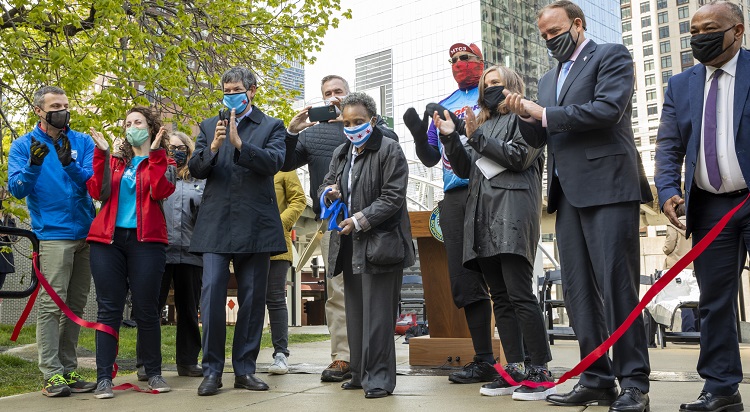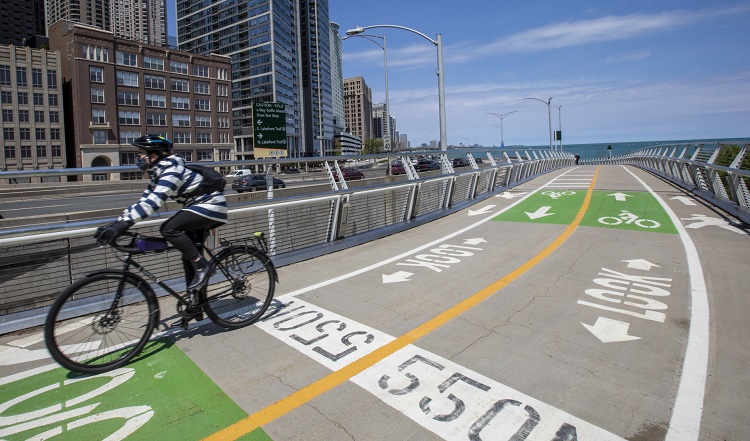Mayor Lightfoot Cuts Ribbon at newly Completed Navy Pier Flyover Project
New Pedestrian and Bike Bridge Over Chicago River Connects the North and South Sides of City, Eliminates Bottlenecks and Creates a Continuous 18-mile Lakefront Trail
Mayor’s Press Office 312.744.3334
press@cityofchicago.org

CHICAGO – Mayor Lori E. Lightfoot today joined Governor Pritzker, the Chicago Department of Transportation (CDOT), the Chicago Park District, and other state and local officials at the ribbon cutting for the Navy Pier Flyover Project. The transformative pedestrian and bike bridge links the two halves of Chicago’s signature Lakefront Trail and creates an uninterrupted, 18-mile ribbon from 71st Street to Hollywood Avenue.
"The Lakefront Trail is undoubtedly one of Chicago's crown jewels—a reputation that has only been amplified thanks to the completion of the Navy Pier Flyover project, which seamlessly connects our North and South Sides," said Mayor Lightfoot. "This incredible project also improves public safety and provides stunning views of our lakefront and Navy Pier for pedestrians, joggers, and bikers alike. I am thrilled to finally be able to cut the ribbon to this project and open it up for our residents to enjoy just in time for the summer."
Chicago is known for hosting millions of visitors each year to explore it’s beaches, parks, museums— and the Chicago Lakefront is a significant part of the City’s tourism industry. Individuals are drawn to the iconic skyline from around the world and this new addition will greatly improve the experience of residents and visitors alike, which is fundamental in the City’s effort to recover from the COVID-19 pandemic.

The Navy Pier Flyover is a steel and concrete pedestrian and bike bridge that was constructed along the east side of the Lake Shore Drive Bridge. It extends for almost half a mile (2,160 feet) from Jane Addams Park and the Ohio Street Beach to DuSable Harbor on the south side of the Chicago River. It also includes a ramp for pedestrians and bikes that connects the trail to Navy Pier. The project was built in three phases starting in 2014 as funding became available, which resulted in the timeline being stretched out longer than initially anticipated. Funding for the $64 million project came from federal and state sources.
“I'm proud that the State of Illinois was able to provide funding to support the completion of the Navy Pier Flyover Project — an investment that offers a safer alternative to the busy intersections along the Lakefront Trail for pedestrians and bikers,” said Governor JB Pritzker. “This project will help connect the north and south lakefront and represents what we can achieve when we invest in our cities’ transportation network. As we gear up for an exciting summer ahead, this will help residents and visitors alike safely explore what the great City of Chicago has to offer.”
The Flyover portion of the project which carries the Lakefront Trail over Illinois Street and Grand Avenue was opened at the end of 2018. This eliminated two major bottlenecks on the Lakefront Trail at Lower Lake Shore Drive and Illinois and Grand, where on busy summer weekends thousands of people walking, jogging and riding bikes had to share space with cars.
The final major element of the project involved tunneling through the two bridge houses on the east side of the movable bridge to allow for widening the trail to more than 16 feet. Widening this segment over the Chicago River also required retrofitting the existing bridge with a cantilever structure on the east side of the span. Before the widening, the section over the bridge varied from 12 feet to 8 feet at several pinch points. The new, expanded pedestrian and bike trail over the river will range from about 19-1/2 feet to 21-1/2 feet.
“Building the Navy Pier Flyover was an incredibly complex design and engineering challenge,” said CDOT Commissioner Gia Biagi. “The final product is a critical and long-awaited improvement at an intensely busy point in the trail. Paired with the Park District’s work to provide trail separation, the Flyover now seamlessly connects our north and south lakefront for the hundreds of thousands of people who use it throughout the year.”
“This is a great day for everyone in Chicago who spends time walking, jogging or biking along our beautiful lakefront,” 42nd Ward Alderman Brendan Reilly said. “In addition to making the Lakefront Trail safer and easier for everyone to enjoy, the project offers a spectacular view of the lake.”
“Chicago lakefront parks and trail are among our city’s most popular destinations,” Chicago Park District General Superintendent & CEO Michael Kelly said. “The completion of the Navy Pier Flyover and Lakefront Trail Separation will dramatically minimize congestion, making the experience more enjoyable and safer for everyone.”
The Flyover project has already won several awards, including the ACEC of Illinois Lincoln’s Grand Conceptor award this year, and was listed as one of the Top 10 Bridge Projects of 2020 by Roads & Bridges Magazine.
The designer for phases 1 and 2 was HNTB and Muller + Muller; the designer for phase 3 was WSP USA.
The Prime contractor for phase 1 was FH Paschen; the prime contractor for phases 2 and 3 was Granite Construction. TY Lin was the construction manager.
Following are details of the three phases of the project:
Phase 1 - North Segment: Starting at the north end of Jane Addams Park, the path rises over the Ohio Street underpass and Grand Avenue onto upper Lake Shore Drive behind Lake Point Tower. It then crosses over Illinois and terminates north of Ogden Slip. It includes a ramp that leads down to Navy Pier, following the alignment of the Lake Shore Drive off-ramp.
Phase 2 - DuSable Segment: This portion consists of a 16-foot-wide multipurpose bridge from the north end of the Chicago River Bridge, running adjacent to Lake Shore Drive and over DuSable Park to just north of Ogden Slip. The new steel structure includes a steel spine, which achieves a smooth and complex horizontal and vertical alignment necessary to clear existing Lake Shore Drive and area structures.
Phase 3 - Chicago River Bridge Segment: This segment was the most complex to construct as it involved retrofitting the existing movable LSD bridge with a cantilever structure off the east side of the bridge. It also doubles the width of the sidewalk on the east side of the lower level of the LSD movable bridge to at least 16 feet; the northbound side of the new path tunnels through the existing bridge houses in order to achieve this additional width. This phase also involves needed structural and mechanical repairs to the movable bascule bridge.
The structural and mechanical work on the LSD Bridge will be continuing through 2021.
